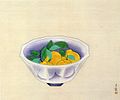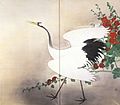|
Kokei Kobayashi
Kokei Kobayashi (小林古径, Kobayashi Kokei, February 11, 1883 – March 3, 1957) was a Japanese Nihonga painter.[1] BiographyHe became an orphan early in his life, at the age of 17 he moved to Tokyo and studied traditional Japanese painting at Kajita Hanko.[2] Later he became one of the most notable members in the Restored Japan Academy of Art.[3] Initially, he painted traditional subject matter ("Taketori monogatari"-1914 as an example) but later he continued with still life and contemporary scenes. His famous works include: "Amida-dō" (1914), "Ideyu" (1918) and "Kami" (1931).[3] He was friends with Tamako Kataoka (1905–2008). He was awarded the Order of Culture. Works
See also
References
External linksWikimedia Commons has media related to Kobayashi Kokei.
|
||||||||||||||||||||







